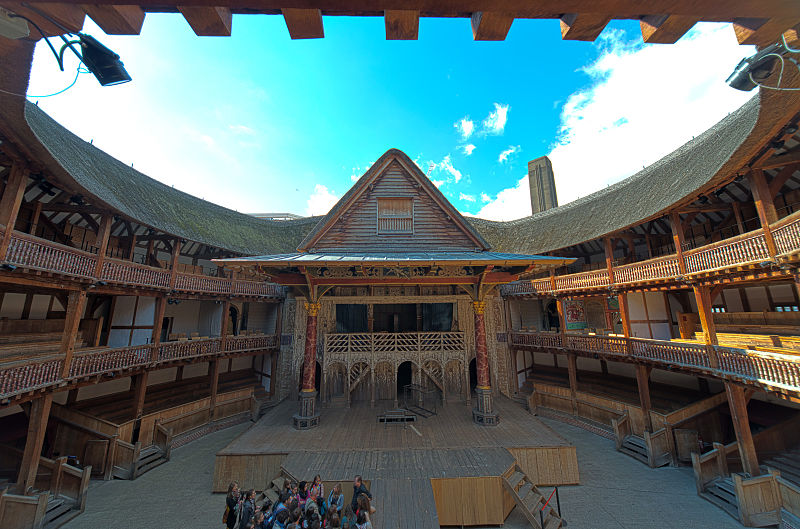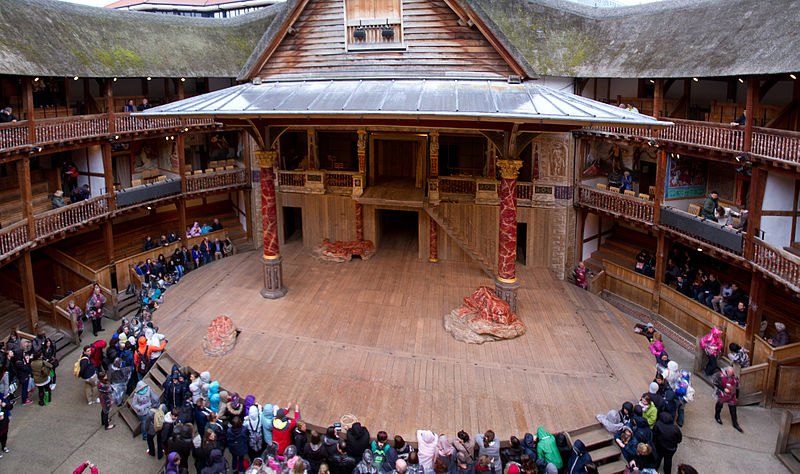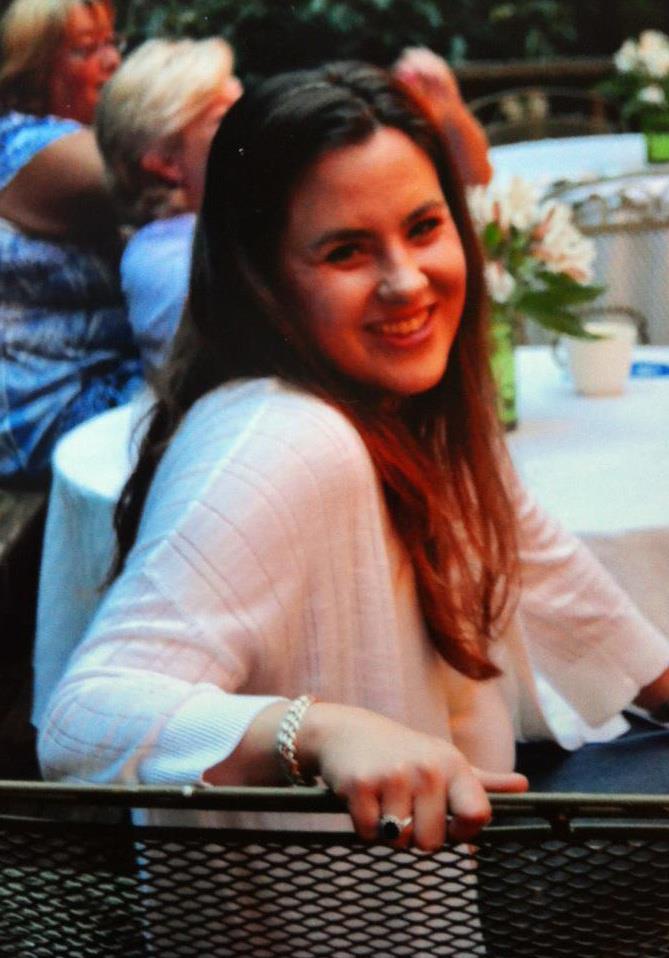Attending a play at Shakespeare’s Globe was a fascinating experience quite different from going to a theater today.
 Globe Theater from the Outside
Globe Theater from the Outside
The first time London opened a theater where patrons could come to see a production, as opposed to traveling players going to the audience in noble homes or private parties, was when James Burbage constructed The Theater in London when William Shakespeare was just 12 years old. 16th century England was experiencing this new form of entertainment for the first time, with people like William Shakespeare creating a theater going event for the very first time. Here is an overview of what it would have been like if you were a Tudor going to see a play in Shakespeare’s Globe.
 Steve Collis from Melbourne, Australia
Steve Collis from Melbourne, Australia
No One Dimmed the Lights
No dark theater aisles here. Despite not having electricity, the Elizabethan playwrights were especially good at using the one source of light they had available to them: The sun.
William Shakespeare himself was quite innovative at using sunlight, improving on the design of Burbage’s The Theater with The Globe, which was designed specifically to utilize the sunlight in particular. With its open ceiling and round circle shape, the theater allowed the sunlight to stream in during the afternoon when plays were most often performed, and shine on the stage itself to illuminate the actors as they played.
 Tony Hisgett from Birmingham, UK
Tony Hisgett from Birmingham, UK
Standing Room Only
In what would most likely be called an “orchestra pit” today, the Globe theater was designed so that the bulk of the audience stood in an open area just beyond the stage called the yard. The stage itself was an Apron stage, designed to jut out into the audience so that when actors were performing on stage they were literally staring at the audience members as they performed. In fact, specific theater conventions like the aside, where actors ask the audience for advice or have a conversation that only the audience (and not the other characters on stage) know about, worked extremely well in this environment precisely because the audience was involved in the play itself.
It wasn’t all standing room only, however. Along the outside of the yard stood three levels of higher priced seats where you could sit in the Gallery and observe the play from a seat which was often covered from the elements like rain or snow which groundlings were not protected from in the yard. Theatergoers were allowed to pay extra to have a cushion in the gallery seats, but for most patrons, it was simply a wooden bench.
Despite the humble comforts, a wooden bench seems to modern theatergoers used to plus velvet seats in neatly arranged rows, these wooden seated gallery tickets were high priced because they tailored to the nobility. It was only the rich and high-class citizens who were allowed to sit in the gallery.
An example of an Apron Stage jutting out into the audience at The Globe, Melbourne.

An example of an Apron Stage jutting out into the audience at The Globe, Melbourne. Steve Collis from Melbourne, Australia
The Audience was Smelly
In Elizabethan England, bathing was not an activity people did every single day like proper 21st-century hygiene would suggest. In fact, hygienic in general were of the sparse variety for the poor and lower class citizens who frequented The Globe theater which meant when you walked in, you smelled a cornucopia of rank odors. From the mud on people’s shoes to the urine, feces, animal dung, sweat, beer, and food, the atmosphere inside the theater was anything but refined and in actually was quite pungent.

With so many people crowded into the yard, the sound was significant, and the crowd often became quite rowdy. From the book “Shakspere to Sheridan; a book about the theatre of yesterday and to-day”
No One Whispers
Despite the modern reputations of theaters as a place similar to libraries where people are supposed to speak in hushed tones, if they speak at all, inside The Globe theater the sounds were loud and rancorous. Particularly in the yard where the poor and groundlings gathered to watch the plays, they had a reputation for being obnoxious, heckling the actors, yelling at performances they did not approve of, and even throwing things if they were disgusted at the portrayals before them.
Disapproval from the audience took multiple forms in that audience members would express displeasure at the actions of the character, disapproving for example, of how one king handled the historical situation. However, the audience’s displeasure with the actors themselves, including the ability to find the actor believable in a particular role, was a crucial aspect of acting on stage in Elizabethan England. If the audience did not like the actor themselves or felt the performance was done poorly, that actor would not be kept on in the company.

They Ate Hazelnuts like Popcorn
Attending a play at the Globe had, in some ways, more similarity with going to a movie theater than to a stage performance. Members of the audience would often bring in snacks, food, and drinks to consume while watching a production in the same way people in the United States often buy popcorn when going to see a movie.
In addition to the spectators bringing in food to eat while watching a show, there were often vendors in and around the theater selling ale, beer, and hazelnuts for the patrons to eat at the show. In excavations of Elizabethan theaters, archaeologists have uncovered spoons, bottles, shells of oysters and hazelnuts, as well as the remnants of various fruits and nuts.

The Tiring House is the part inside this little triangle shaped section over the roof of the apron stage. It was used to house props, as an entrance point for spirits who needed to descend from heaven, as well as musicians to sit when playing for the accompaniment of the action on stage. Jeff Hitchcock
There was Music
We are so used to the idea of a soundtrack today that it may come as a surprise to you that music played a pivotal role in Shakespeare’s performances. Whether it was a musician sitting in the Tiring House above the stage playing flourishes at the entrance or exit of a character, or it was musicians being included in the actions of the play through play-within-a-play or a character singing a song, the music was an integral part of what was happening on the stage.
Characters interacted with music on stage much more in Shakespeare’s day than they did now. For example, today’s audience is used to a soundtrack playing the background, or a tense trill of music increasing in pace as we watch a crime show to indicate the bad guy is about to appear.
However, for William Shakespeare’s cast of characters, the character (as opposed to just the actor playing the character) would have been aware of and interacting with the music which was included in the plot of the story. Unlike modern theaters which have an orchestra pit, Shakespeare’s musicians would have had a place in the cast, seats off to the side of the stage, or would have sat above the stage itself in the Tiring House to play on their cue.

What you can see on the stage now is similar to the kind of background all of Shakespeare’s plays performed at The Globe would have used in production.
There was Limited Background Scenery
Large-scale scenery paintings to stand behind the actors as they perform a scene on stage was a theater convention invented after Shakespeare. For William Shakespeare, his actors did have some special effects like thunder, stage blood, and even descent of heavenly spirits from the skies, were all available to Shakespeare as well as used creatively and profusely. However, when it came to the set design, background scenery was kept to a minimum.
Instead, actors on stage brought essential props with them, like swords, crowns, or even a throne, grave, or other items which would indicate their location. Largely, when it came to describing where a character was at, or what he was doing, instead of relying on set design, Shakespeare’s plays relied on the dialogue of the characters themselves, which is one reason Shakespeare’s plays contain so many long speeches. The characters are describing for you what they want you to understand where they are and what’s happening.

17th century English actor Thomas Betterton in a scene from William Shakespeare’s Hamlet, in which the Ghost of Hamlet’s Father confronts him in his mother’s chamber. From Nicholas Rowe’s edition of Shakespeare’s works (1709). Here, Betterton’s wife Mary scandalously played Hamlet’s mother in a time when women on stage were considered notoriously indecent.
There Were No Women on Stage
In Shakespeare’s day, it was illegal for a woman to appear on stage. It was considered indecorous at best, and outright immoral at worst. Therefore, Shakespeare’s playing companies were completely male casts with young boys playing the parts of women. With their higher voices, smooth skin, and excellent costumes, they could pass for women on stage.
It wasn’t purely a young man’s higher voice and costume that allowed them to appear as a woman on stage, however, makeup played a key role in this illusion as well. For Shakespeare’s acting company, anyone appearing on stage white-faced, covered with a lime-based makeup paint which made the skin appear white, was automatically known to be a woman because only women wore this makeup. Famously, Queen Elizabeth was quite fond of this makeup.
The Plays Were Not at Night
The elegant time to attend a theater production these days is the evening show of 7:30pm. However, for Elizabethans, they did not have electricity, so their day started and ended with the sun. Therefore, the work day for most Elizabethans wrapped up in the afternoon, and they were home by 5 for dinner. That’s why most productions at The Globe happened around 2:00pm, because it’s after work, before dinner, and while there was still enough daylight to be able to see inside the theater.
Times and theater going may have changed significantly since Shakespeare was staging productions at The Globe (God Bless You, Indoor Plumbing), but one thing remains the same: the power and triumph of Shakespeare performances carry right through to the 21st century, ready on any stage to bring a great story to life.
. . .
Would you like a printable diagram of The Globe theater? Sign up to Cassidy’s That Shakespeare Girl weekly newsletter and you will be able to instantly download a brochure about our upcoming Trip to see The Globe in London, as well a hand illustrated guide of The Globe (normally $12 from Cassidy’s shop). Download your free right here: https://www.cassidycash.com/download-a-diagram-of-the-globe-theater/
Travel with me: Tour the Life of Shakespeare
Travel with me and British History Tours. Spend 5 Days/4 Nights seeing every iconic site related to William Shakespeare we could possibly cram into one trip. You don’t want to miss it! More details and sign up here. www.cassidycash.com/travelshakespeare
 Cassidy Cash, is the host of That Shakespeare Life, the podcast that takes listeners behind the curtain and into the real life of William Shakespeare. Cassidy believes that in order to understand and perform Shakespeare’s plays, understanding the history of the man who wrote them is essential. She uses art, animated short films, and a podcast to help you learn something new about the bard. When she is not researching Shakespeare, she homeschools two boys, enjoys cooking new recipes, and drinking too much coffee. Cassidy lives in Birmingham, AL with her husband, Tim, a mountain of books, more pets than what’s reasonable. Connect with Cassidy on Twitter @thatshakespeare, or at http://www.cassidycash.com
Cassidy Cash, is the host of That Shakespeare Life, the podcast that takes listeners behind the curtain and into the real life of William Shakespeare. Cassidy believes that in order to understand and perform Shakespeare’s plays, understanding the history of the man who wrote them is essential. She uses art, animated short films, and a podcast to help you learn something new about the bard. When she is not researching Shakespeare, she homeschools two boys, enjoys cooking new recipes, and drinking too much coffee. Cassidy lives in Birmingham, AL with her husband, Tim, a mountain of books, more pets than what’s reasonable. Connect with Cassidy on Twitter @thatshakespeare, or at http://www.cassidycash.com
